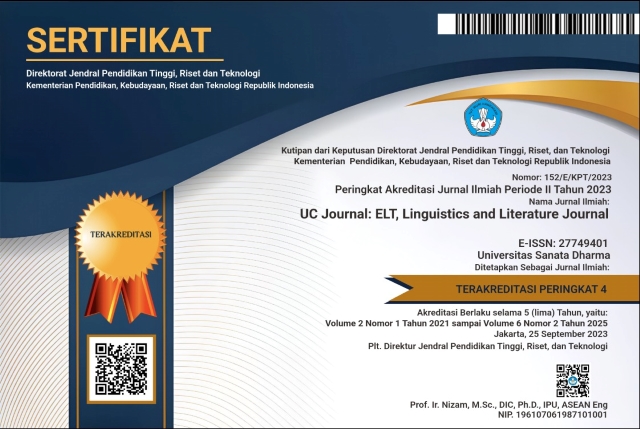UNDERSTANDING LANGUAGE REVITALIZATION STRATEGIES IN INDIGENOUS LANGUAGE SCHOOLS IN NORTHWEST AREA OF THE UNITED STATES
(1) University of Montana
(*) Corresponding Author
Abstract
The expansion of globalization and the demand to establish one lingua franca for international communication has brought a significant impact on the decline of local languages around the globe. This issue calls for language revitalization programs so that all the Indigenous languages can be passed on to the younger generations. This small-sample-qualitative study describes the strategies used by Indigenous language schools in the Northwest area of the United States and further elaborating on the unique elements of those strategies. Five websites covering the information on Indigenous language school programs in Kalispell, Inchelium, Spokane, Browning, and Arlee were analyzed. In general, schools emphasize the relationality between elders, community, and educational institutions to preserve the language successfully. In addition, technology was utilized to help younger generations access materials more easily. This connection was built through creating listening materials by recording and transcribing the remaining fluent speakers, recording songs and lullabies, introducing Indigenous languages through storybooks, and launching mobile-friendly language apps.
Keywords
Full Text:
PDFReferences
Austin, P. K., & Sallabank, J. (Eds.). (2011). The Cambridge handbook of endangered languages. Cambridge University Press.
Begay, W. R. (2013). Mobile apps and indigenous language learning: New developments in the field of indigenous language revitalization. Retrieved on May 20, 2022, from http://www.malsmb.ca/docs/mobile-apps-and-indigenous-language-learning-usa.pdf
Cain, S. (September 2019). Six ways Northwest Natives are using tech to save their languages. The Seattle Globalist. Retrieved from https://seattleglobalist.com/2019/05/29/six-ways-northwest-natives-are-using-tech-to-save-their-languages/85189
Creswell, J. (2007). Qualitative inquiry and research design: Choosing among five approaches (2nd ed). Thousand Oaks, CA: Sage Publication, Inc.
Edward, J. (2012). Multilingualism: Understanding linguistic diversity. New York: Continuum International Publishing Group.
First Peoples’ Cultural Council. (2018). Recognizing the diversity of first nations languages. Retrieved on March 15, 2022, from https://fpcc.ca/resource_year/2018/
Fishman, J. (1996). What do you lose when you lose your language? Retrieved on December 18, 2021, from https://eric.ed.gov/?id=ED395732
Galla, C. K. (2018). Native American youth and language learning and use. The TESOL Encyclopedia of English Language Teaching, 1-7. https://doi.org/10.1002/9781118784235.eelt0831
Gumperz, J. J. (1964). Linguistic and social interaction in two communities. American Anthropologist, 66(6), 137-153. https://doi.org/10.1525/aa.1964.66.suppl_3.02a00100
Harmon, D., & Loh, J. (2010). The index of linguistic diversity: A new quantitative measure of trends in the status of the world's languages. Language Documentation & Conservation, 4, 97-151.
Hawes, B.L. (1974). Folksongs and function: Some thoughts on the American
lullaby. The Journal of American Folklore, 87(344), 140-148.
Hinton, L. (2001). Language revitalization: An overview. The green book of language revitalization in practice, 1, 18. https://doi.org/10.1163/9789004261723
Inchelium Language and Culture Language Association. (n.d.). Saving our language, one language teacher at a time. Retrieved on December 18, 2021, from https://incheliumlanguagehouse.com/
Kalispel Tribe of Indians. (n.d.). Our Language. Retrieved on December 18, 2021, from https://kalispeltribe.com/our-language/
Kamenetz, A. (November, 2016). Six potential brain benefits of bilingual education. Retrieved on December 18, 2021, from, https://www.npr.org/sections/ed/2016/11/29/497943749/6-potential-brain-benefits-of-bilingual-education
Krauss, M. (1996). Status of Native American language endangerment. Stabilizing indigenous languages, 16-21.
Leedy, P. D. & Ormrod, J. E. (2005). Practical research: Planning and design (8th ed). New York: Pearson Prentice Hall.
Meighan, P. J. (2021). Decolonizing the digital landscape: The role of technology in Indigenous language revitalization. Alternative: An International Journal of Indigenous Peoples, 17(3), 397-405. https://doi.org/10.1177/11771801211037672
Merriam, S. B. (2002). Qualitative research in practice: Examples for discussion and analysis. San Fransisco: Josey-Bass publisher.
Miles, M. & Huberman, M. (1994). Qualitative data analysis (2nd ed). Thousand Oaks, ca: Sage Publication, Inc.
Miyashita, M., & Shoe, S. C. (2009). Blackfoot lullabies and language revitalization. Indigenous language revitalization: Encouragement, guidance & lessons learned, 183-190.
Moseley, C. (Ed.). (2010). Atlas of the World's Languages in Danger. Unesco.
Rainey, W.D., & J.D. Larsen. (2002). The effect of familiar melodies on initial learning and long-term memory for unconnected text. Music Perception, 20(2) 173-186. https://doi.org/10.1525/mp.2002.20.2.173
Spokane Tribe Language and Culture. (n.d.). Back to the Heart Immersion School. Retrived from https://www.spokanelanguageculture.com/immersion-school
The Piegan Institute. (n.d.). Why Language Is Important? Retrieved from https://www.pieganinstitute.org/the-language
UNESCO Institute for Lifelong Learning. (March, 2016). Isirawa Language Revitalization Programme (ILRP), Indonesia. Retrieved on September 30, 2021, from https://uil.unesco.org/case-study/effective-practices-database-litbase-0/isirawa-language-revitalization-programme-ilrp
DOI: https://doi.org/10.24071/uc.v3i1.4682
Refbacks
- There are currently no refbacks.
Copyright (c) 2022 Sisilia Novena Kusumaningsih

This work is licensed under a Creative Commons Attribution-ShareAlike 4.0 International License.
UC Journal is indexed in:
UC Journal Sinta 4 Certificate (S4 = Level 4)
We would like to inform you that UC Journal: ELT, Linguistics and Literature Journal, or UC Journal has been nationally accredited Sinta 4 by the Ministry of Education, Culture, Research and Technology of the Republic of Indonesia based on the decree No. Surat Keputusan 152/E/KPT/2023. Validity for 5 years: Vol 2 No 1, 2021 till Vol 6 No 2, 2025
DOI: https://doi.org/10.24071/uc
e-ISSN (validity starting Vol 1, No 2, November 2020): 2774-9401

This work is licensed under CC BY-SA.
Creative Commons Attribution-ShareAlike 4.0 International License
 UC Journal: ELT, Linguistics and Literature Journal, a scientific peer-reviewed journal, was established in 20 May 2020 and is published twice a year, namely in May and November, by the English Language Education Study Programme (S1/Sarjana PBI) in collaboration with the English Education Master's Programme (S2/Magister PBI) of Sanata Dharma University, Yogyakarta, Indonesia.
UC Journal: ELT, Linguistics and Literature Journal, a scientific peer-reviewed journal, was established in 20 May 2020 and is published twice a year, namely in May and November, by the English Language Education Study Programme (S1/Sarjana PBI) in collaboration with the English Education Master's Programme (S2/Magister PBI) of Sanata Dharma University, Yogyakarta, Indonesia.














